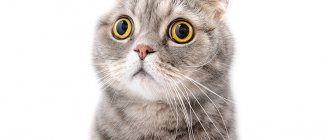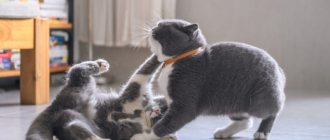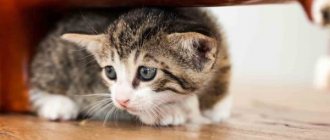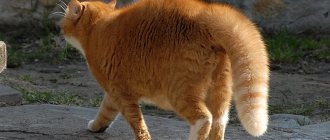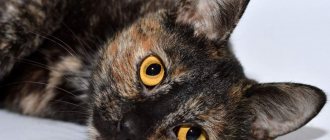If a cat falls from a height and lands unsuccessfully, then injury and bruise cannot be avoided. Of course, the health of the animal is not threatened by jumping from a cabinet, table, bed or tree. But if a cat fell out of a window from the fifth floor or even from the third, there is a high probability of fractures, concussion, and damage to internal organs. Therefore, if a cat accidentally falls from a great height and has characteristic signs of damage, it is necessary to urgently take the pet to the veterinary clinic.
What are the symptoms of serious injury after a fall?
A cat falling from a height of the 6th floor is considered more dangerous than, for example, from the 7th. The animal simply does not have time to group itself in the process and land normally. Falling from the ninth floor and above is dangerous because a fairly high speed develops, and the impact on the ground becomes stronger.
Cats love to sit on the windowsill and watch the world around them.
If an accident occurs, you need to find the animal as quickly as possible. Often owners, without noticing obvious signs, calm down and do not go to the veterinarian. However, even if the cat does not clearly show its poor condition, you should carefully monitor the animal’s behavior and pay attention to all the slightest changes.
Fractures and bruises
Most often, cats that fall from a height have bruises and fractures. Such phenomena are characterized by the following symptoms:
- With severe bruises, hematomas may appear at the site of injury; the cat does not allow the sore spot to be touched.
- Fractures are more difficult to detect - they can be open or closed. When open, the bone comes out, tearing muscle tissue and skin. Such a fracture is dangerous because infection can get into the wound. However, with prompt assistance, the risk to the animal is minimal.
- A closed fracture remains inside and cannot be immediately identified visually. A cat may have a simple crack in the bone, but without proper diagnosis and treatment, such an injury can cause negative consequences.
- A pelvic fracture is characterized by the inability to raise the hind legs.
- Damage to the limbs is noticeable if the animal is unable to lean on them and keeps them in an elevated state.
- With fractures, the limbs are unnaturally rotated, very mobile, and if there are cracks at the site of injury, an inflammatory process appears.
When palpated in the painful area, cats show aggression and try to dodge.
Cats are always trying to find some kind of loophole.
Bleeding
Bleeding can be internal or external. You should pay attention to the following symptoms:
- presence of bleeding from the nose, ears, mouth;
- the presence of serious wounds on different parts of the body;
- an enlarged abdomen indicates possible damage to internal organs and internal bleeding;
- the presence of blood in the urine indicates possible kidney damage;
- blood from the anus can also be a sign of internal organ damage.
Important! If your pet's mucous membranes become pale, it practically does not move and blood flow is noticeable, you should immediately consult a veterinarian.
Traumatic brain injuries
Head injuries are not always noticeable unless they are obvious. The cat may behave quite normally. However, if there are some signs you should be wary:
- problems with coordination, awkward movements;
- limping gait;
- lack of activity, the pet often sleeps and does not want to move;
- presence of aggression, the cat does not recognize its owners well;
- If the condition worsens, it is possible that convulsive manifestations may occur throughout the body or some parts of the body.
Brain concussion
When a concussion occurs, an animal may vomit and gait may be impaired. In most cases, after a fall from a height, the cat is lethargic and does not eat anything and sleeps constantly.
Sometimes cats can just get stuck and get hurt
Prevention: what to do?
Valeria Oleinik, a veterinarian at the 911 clinic, advises closely monitoring the safety of cats, which often like to climb to heights and jump from there. Therefore, before leaving for work, do not forget to check all windows and balcony doors; for greater safety, it is recommended to install window protective nets. If a cat dies after falling from a great height, the owner does not need to blame himself, although it is not easy to survive such a loss. It is important to draw the right conclusions from the current situation and try to eliminate the factors that caused the tragedy.
First aid for falling from a height
What to do if a cat fell from the 3rd floor? Carefully examine the animal and go to the doctor. In most cases, this height does not pose any particular danger to cats.
The cat fell from the 5th floor: consequences, what to do
If a cat fell from the 6th floor, then you need to immediately take the necessary measures and provide first aid to the injured animal. It includes several actions that should be carried out in the first couple of hours after the fall:
- First of all, you need to find the cat and examine it without touching it.
- If the animal cannot move, then you need to try to put something flat under it - a sheet of thick cardboard, plywood, the bottom of a carrier, the head needs to be fixed.
- The pet is immediately taken to a veterinary clinic or taken home, but they try to ensure peace.
- If the cat is unconscious, resuscitation is carried out - the mouth is opened, the tongue is pulled out, the nose is closed with the fingers. Then artificial respiration must be performed through gauze - air is blown into the animal’s mouth. It is important to monitor the movement of the diaphragm.
- Bandages soaked in solutions of furatsilin or chlorhexidine are applied to areas of open damage. If necessary, replace with fresh ones.
- If internal bleeding is suspected, cold compresses may be applied to the cat's abdomen and head.
Important! Arbitrary use of medications and self-treatment is not allowed. Such measures often lead to negative consequences.
After a fall, you should not move the cat intensively, try to feed or drink it, try to straighten dislocations or apply a splint, or tilt its head back.
If a kitten falls from a height, the owners do not always know what to do and are often lost. When your baby falls out, you need to see a doctor very quickly. Kittens have a less developed immune system and body as a whole; a small loss of blood will negatively affect their condition.
Which floors are more dangerous to fall from?
Traditionally, the most dangerous floors for a cat to fall are considered to be from the 3rd to the 5th. The fact is that this is such a height that is already dangerous, but at the same time insufficient for the cat to have time to regroup in flight and fall on its paws.
Floors 5 to 9 are considered the safest, because... at such a height, the cat already has time to regroup, but its shock-absorbing capabilities are still enough to withstand injuries from a fall.
But in general the pattern is this: the higher the floor, the more dangerous it is. But there are cats who have successfully fallen from the 11th floor, getting off with only a slight fright.
What diagnostic methods are needed in a clinical setting?
A cat pees on the bed: what should the owner do?
In veterinary clinics, first of all, a thorough diagnosis is carried out. It allows you to identify all damage - visible and invisible - and select the most appropriate treatment. To make an accurate diagnosis, the following examinations are used:
- general blood and urine tests;
- X-ray examination of the chest to determine fractures and bruises of the ribs, lungs and other organs;
- X-ray of the spine, bones, joints, hip to exclude fractures;
- ultrasound examination of internal organs to determine the condition and presence of damage.
If necessary, the doctor will prescribe additional examinations that will help determine the cause more accurately.
If necessary, place an IV
Signs and symptoms of presyncope: dizziness, nausea
Symptoms of presyncope are characterized by sudden development, which is usually provoked by certain factors. A stuffy room, tight clothing, stressful situations, excessive physical activity, eating - all this can contribute to the onset of an attack.
The most characteristic symptom of presyncope is dizziness, which may be accompanied by nausea. This indicates disturbances in the functioning of the human autonomic system.
There is a certain risk group of people for whom the presyncope may be permanent. These are people suffering from hypotension (low blood pressure), chronic anemia (low hemoglobin level in the blood, less than 100 units), bradycardia (low heart rate, less than 40 beats).
Any of the described signs is a serious reason to see a doctor. But, since an attack of pre-fainting can occur at any time and in any place, it is necessary to have at least a general understanding of how to provide first aid to the victim or yourself at home.
Cats falling from a height - treatment in the clinic
After sterilization, the cat asks the cat: is this normal and what to do?
After research and diagnosis, suitable treatment is selected. At the first stage, the cat is given special sedatives to relieve the state of shock and relieve the animal from stress. Severe nervousness leads to disruption of the functioning of all organs.
If necessary, surgery is prescribed to eliminate internal damage. In case of fractures, the bone tissue is connected and plaster is applied.
If you have a traumatic brain injury, you may need to use a ventilator.
The animal is prescribed a number of suitable medications that will help rapid recovery, and droppers with medicinal solutions are placed. The cat's condition is monitored daily.
For fractures, plaster is applied to the damaged areas
Diagnosis and treatment
If a falling cat was unable to land on its feet and was seriously injured, it is necessary to urgently take it to a veterinary clinic. During the initial examination, the doctor will understand whether the animal can stand and move independently. If all the symptoms of a fracture of the spine or limbs are present, radiography is prescribed. If a concussion is suspected, an MRI is performed. If the cat does not go to the toilet for a long time, an additional ultrasound of the bladder is prescribed, since internal organs are often damaged when falling.
After confirming the diagnosis and determining the extent of damage, treatment is prescribed. If it is possible to find fractures, a plaster cast or a fixing bandage is applied. It is important to ensure that the animal moves less. For a concussion, the following groups of drugs are prescribed:
Depending on the diagnosis, certain medications are selected for the animal.
- painkillers;
- sedatives;
- normalizing cerebral circulation and pressure;
- antiemetics.
If the cat has become nervous, does not recognize the owner and is constantly trying to jump off the hands, additional consultation with a neurologist will be required. To suppress nervousness and aggression, a long course of potent sedatives is prescribed. Antibiotics may be prescribed to prevent inflammation at the site of injury. Sometimes it happens that after a fall from a great height, the animal does not pee and cannot go to the toilet for the most part. In this case, in addition to drug treatment, abdominal massage is prescribed. For successful recovery, it is important to provide your pet with physical and emotional peace.
Consequences
If a cat falls from the third floor or lower, then in most cases there are no serious consequences. The animal is in shock for a while and then lives a normal life.
If you jump from the sixth, seventh or higher floors, the risk of serious damage increases significantly. The consequences of a cat falling from a height are immediate and secondary.
The first group includes arrest of the respiratory process and heart, serious blood loss, and shock.
Secondary consequences arise after some time. These include inflammatory processes in internal organs, impaired functioning of the kidneys and liver, infections entering the wounded surface, and blood poisoning.
With correct and timely assistance, negative consequences rarely occur.
Important! It is necessary to quickly take your pet to the hospital to reduce the risk of developing malfunctions in the functioning of organs and systems.
How to provide first aid?
If a cat has disappeared from your apartment, you will most likely be able to find it on the street. You need to carefully look for the animal under a tree or bush, because often after an injury the cat tries to crawl away and hide. If the cat does fall from the balcony and there are all signs of damage, it is important to provide him with first aid:
An animal that has been seriously injured should not be handled.
- If damage to the spine or skull is suspected, it is prohibited to pick up the animal or try to move it. This will cause even more damage and unbearable pain.
- If a cat falls from the windowsill and loses consciousness, do not bother him. It is necessary to check the respiratory function, and if it is absent, try to perform artificial respiration.
- If a concussion occurs, your pet may vomit violently. If the cat does not get up on its own, you should raise its head so that the vomit does not enter the respiratory system.
- If a cat has damaged internal organs after a fall, it is important to immobilize it. To relieve pain, it is recommended to apply a cold compress to the stomach and head.
- If the injury is serious, the animal will not eat or drink water. You should not force him to take food by force; at this moment the body does not need food.
How to prevent a cat from falling out of a window
Cats love heights, so they don't feel much fear. The result is often falls and serious injuries. It is possible to protect an animal from such a situation by following safety rules:
The safety of the animal depends on the owner
- If the animal likes to sit on the windowsill, then it is recommended to take care of durable mosquito nets that can withstand serious pressure.
- Nets should also be placed on the balcony to prevent the possibility of falling from it.
- When leaving the apartment, be sure to check all the windows; in the absence of the owner, cats become even more curious.
- If your pet experiences falls from the bed, cabinets, or other places while sleeping, you should contact your veterinarian for an examination. Perhaps this is a sign of some disease.
If a cat falls from a height, then in most cases the fault lies with the owner. Inattention and absent-mindedness lead to similar consequences. The injured animal is carefully and quickly taken to the hospital for diagnosis and selection of the most appropriate treatment. Following preventive measures will help avoid accidents.
XXI CENTURY Candy Fudge Scented water
266 ₽ More details
Video baby monitor Motorola MBP36S (white)
12900 ₽ More details
Men's clothing size 56
Cat is a skydiver
Everyone knows that a cat always lands on four paws. Why?
Anatomical features
- The cat owes the flexibility of its back to its close connection with the muscles. The elasticity and mobility of the connection of a cat's vertebrae provides it with the ability to bend and twist its body 180°.
- In a cat, muscles and tendons act as the basis for connecting the front legs to the skeleton. What softens the landing is that it is the ligaments and cartilage that take most of the impact when falling.
- The cat's paw pads also play an important role.
Gyroscope Cats have a robust “gyroscope” built into their inner ear.
Fall technique
- When cats fall, they first straighten their head, then their back and paws. Before landing, they arch their backs and bend their paws slightly, distributing the force of the impact across their joints and muscles.
- Cats, like experienced skydivers, know how to control the speed of their fall. At the beginning of their flight, they instinctively extend their limbs, gaining speed. Then they relax and spread their paws to the sides, increasing the body area and air resistance, thereby reducing the speed and force of the impact.
- When falling from a great height, a cat pulls its front paws towards its head and turns part of its body, for example, to the right. She moves her hind legs as far as possible from the body and turns this part of the body in the opposite direction. Thus, the cat rotates as it falls. This slows down the fall to a large extent.
- By putting its front paws forward, the cat stops the rotation. Then she brings the position of the hind legs in line with the front ones. At the last turn, the cat arches its back.
In addition, having a small weight compared to a person, a cat has the advantage of lower impact force. This explains the survival effect of a cat when falling from a height that is limiting for a human.
BUT! Cats perfectly coordinate their actions when falling from a great height. However, its low height does not allow it to group correctly. And when the height is too high, all the cat’s ability to fall is no longer enough. Floors five through nine are less dangerous for cats. For small kittens, falling off a table can also be traumatic. The record holder is the cat Sabrina, who fell from the 32nd floor and escaped with a knocked out tooth and minor damage to her chest.
But! But! But ! From veterinary practice: any fall, regardless of height, can be unsuccessful! Therefore, there is no need to check whether a cat really has nine lives. Believe me, she is alone! And everything possible should be done to ensure that she lives as long and happy as possible. You don’t have to rely on the fact that your pet has walked along the sill of an open window more than once or sat on a balcony ledge without consequences. This is all just for the time being. Therefore, NEVER leave windows open! They must be securely (!) sealed with mesh, and the balconies must be glazed.
Open window
Not all flights end safely. Most jumpers suffer injuries - both physical and psychological. “The black beast,” as her owner calls her, Masyanya fell from the 5th floor and only broke the nail on her hind paw. But after that the cat was replaced. Masyanya remained as playful and understanding, but she began to go to the toilet exclusively under the sofa, on chairs and mattresses. She no longer tried to go to the window. Desperate to cope with the toilet problem, the owners gave Masyanya away.
But even fear and injury can’t always stop a cat’s desire to jump. Arina's cat Stuka fell from the balcony twice, receiving bruises on his hind legs. They stopped letting him onto the balcony. But one night Stuka jumped out of the kitchen window and disappeared into the darkness. Arina recalls: “The loss was discovered only in the morning: we were sleeping in the room and did not suspect anything. I searched, called, asked people... the children found him on the playground - the cat sat up in a tree.” After this, the window was sealed with nylon mesh. For a month the cat enjoyed the views from the window through the mesh cells and jumped again, tearing the corner of the mesh away from the window with his teeth. He was gone for a week. They searched and posted missing persons notices. Arina was already completely desperate when a woman called her and said that the cat was sitting under her window and yelling in a bad voice. Now there is a blocker on the window, and at night Stuka sleeps in the corridor.
How can you tell if a cat has broken its leg?
Even a person far from veterinary medicine can understand that a kitten or an adult cat has broken its leg. This is indicated by external symptoms that accompany a violation of the integrity of the bones of the open limbs.
If there is a closed fracture, when the skin remains intact and the broken bone is not visible, indirect signs will help to recognize the problem.
External signs
You can find out that your pet has an open fracture of the hind or front paw by the following signs:
- Violation of skin integrity. At the site of the skin rupture, muscles, ligaments, bones and their fragments are visible.
- Bleeding of varying intensity. Caused by damage to blood vessels.
- Strong pain. The animal becomes restless, meows pitifully, and does not allow you to approach it. If you try to touch yourself, you may bite. The pet experiences pain when moving and in a passive state. In some cases, due to shock, there is no pain syndrome.
- Impaired mobility. Damage to the paw bone makes it impossible to use it. The animal does not rely on the injured limb, keeps it suspended and moves on 3 legs.
- Changing the natural position of the injured paw. It is pressed in or turned the other way.
- Crunching when palpated. On palpation, a characteristic sound is heard and bone displacement is felt.
Symptoms of a fracture that has no visible manifestations
For a closed fracture:
- The four-legged pet meows pitifully. Not understanding what is happening, he cannot find relief from the pain and behaves aggressively.
- The cat presses its damaged paw, leaning only on its healthy paws when moving. If the bone is only cracked, this sign may not be clearly expressed.
- The appearance of the sore leg changes. The degree of change in the physiological contour of the injured organ largely depends on the type and nature of the fracture. Deformation of the damaged area is also caused by reflex muscle contraction, the appearance of a hematoma, lymphatic extravasation, and edema.
- Extra-articular bone mobility appears. This occurs with a complete fracture of the paw.
- Crepitation occurs, i.e. a characteristic crunching sound in the area of damage. The crunch appears as a result of the friction of bone fragments against each other. This symptom is typical for fresh injuries. It does not accompany all fractures, since soft tissue and blood clots may appear between damaged bone fragments.
- Swelling appears at the site of injury, which increases in size over time.


